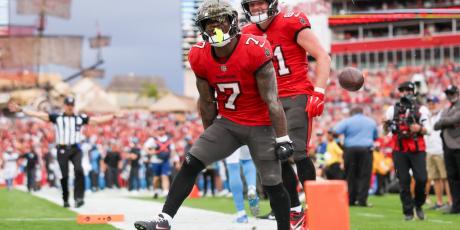2022 Breakout Receiver Model: Week 9

Welcome to the Week 9 edition of the Breakout Receiver Model for 2022. For the uninitiated, John Paulsen built this model with data scientist Kevin Zatloukal and debuted it last season. The model utilizes historical data and recent player performance to help determine players who have received an opportunity that is typically more valuable than their recent production would indicate. This particular model's features include air yards and routes-run data as a means of determining opportunity. It also utilizes a proprietary efficiency metric that looks back at the past 10 weeks of individual player performance, all to better help predict the likelihood of a bounce-back in a player's future production.
The model doesn't have special caveats for changes in personnel, schemes, or situations. Take these results with a healthy grain of salt, and contextualize the numbers with what you know to be true about a player's situation going forward. Remember that the model doesn't explain why a player is underperforming, it can't tell the difference between bad luck and poor play, and as we know, when a player underperforms their expectations it's often a mix of both. When we tested the model in 2020, we found that the underperforming cohort scored, on average, 89% of their expected fantasy points the following week, a solid indicator of the model's proper calibration as it begins to take in data from this season.
The table is sorted by expected fantasy points over the last three weeks, so it's essentially sorted by usage. For this reason, users will note the big names are usually up near the top. Sometimes they've greatly underperformed expectations and other times they have slightly underperformed. The more negative the 'Diff' column, the more they've underperformed. During testing, the likelihood of a breakout varied relative to the 'Diff' but with no noticeable trend. In other words, players with a slightly negative 'Diff' were equally likely to break out as a player with a very negative 'Diff,' so we decided to include all underperformers regardless of how much they are underperforming.
Key
L3 FPts: Average half-PPR fantasy points over the last three weeks. This may only include two games if a player missed a game due to injury or their bye week.
L3 xPts: Average expected half-PPR fantasy points for the last three weeks, based on air yards and routes run data.
Diff: The difference between actual and expected fantasy points over the last three weeks.
P10 FPts: For players with enough data, this is the average fantasy production over the previous 10 weeks. The span begins four weeks ago and extends 10 weeks further.
P10 xPts: For players with enough data, this is the average expected fantasy production over the previous 10 weeks.
P10 Efficiency: This is essentially (P10 FPts / P10 xPts) and gives us an indicator of how well a player historically turns opportunity into production. The higher the efficiency score, the better.

- All Premium Content
- The most Accurate Rankings Since 2010
- Expert Draft Picks w/DraftHero
- Highest Scoring Lineup + Top Available Players w/LeagueSync
- ...and much much more


















